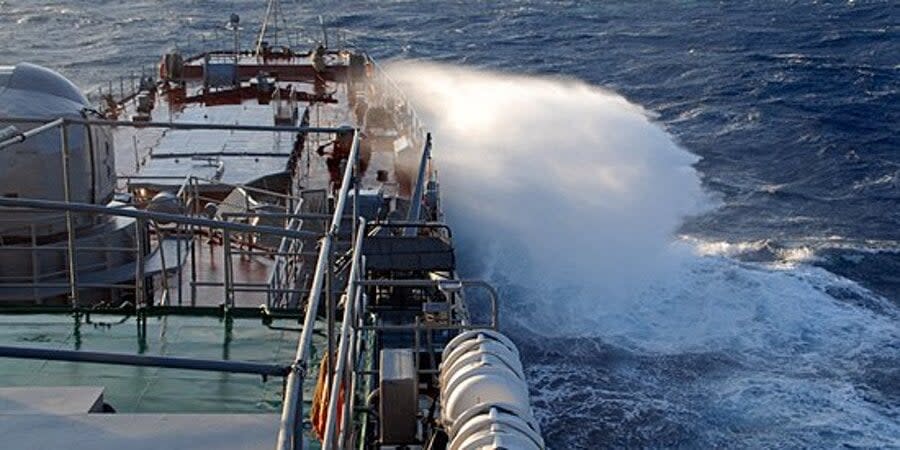Russian warships approached Nord Stream pipelines ‘at least three times before explosions’

Russian warships were spotted twice in June and once in September 2022 — less than a week before underwater explosions hit the Nord Stream pipelines, the team from Denmark’s DR, Norway’s NRK, Sweden’s SVT and Finland’s Yle broadcasting companies reported.
At one point a Russian ship stayed near the location of an explosion for nearly 24 hours.
The vessels had switched off their identifying transponders, but were tracked using radio communications and satellite imagery during these periods.
The journalists managed to find out that a Russian navy ship sailed from the Kaliningrad naval base on June 6, 2022 to the Danish island of Bornholm, where it arrived the next day in the morning.
Read also: Russia again blocks ship inspections in the Bosphorus
"The vessel spent several hours near or even at the location where Nord Stream 1 and Nord Stream 2 cross the seabed at a depth of around 80 metres (262 feet)," a Yle report reads.
The vessel involved in the described incident remains unidentified. However, it was a vessel that was in communication with the Russian naval command center in Kaliningrad, according to a former UK naval intelligence officer who tracked the movement of the ship.
The officer, who used to specialize on interception of the Russian Baltic Fleet, said he found this out using open-source information, the BBC reported.
A Russian naval vessel was next spotted at the same place a week later, on June 14, 2022. It was discovered to have been the 86-meter naval research vessel Sibiryakov, based near St. Petersburg. It remained in the area until the next day.
The ship is designed for seabed mapping and underwater reconnaissance, and is equipped with a crane that can lower objects into the sea.
The beginning and end of Sibiryakov's June route were recorded by high-quality satellite imagery. Part of the route was documented using radar and low-resolution satellite imagery.
One of the images was taken on the morning of June 15, when Sibiryakov was in the area of the future Nord Stream leaks.
Read also: US-sanctioned Russian ship loaded with military cargo enters Black Sea – media reports
The third vessel, SB-123 from the Russian Baltic Fleet, arrived in the area of the explosions on the evening of Sept. 21 last year, five days before the incidents.
Experts said it is a ship for auxiliary and rescue underwater operations that is equipped with a crane with a significant lifting capacity, capable of lifting cargo from the seabed. It can also launch a mini-submarine into the sea.
What’s known about Nord Stream explosions
Pressure in the Nord Stream 2 pipeline dropped from 105 to 7 bars overnight on Sept. 26, 2022. The same problem on Nord Stream 1 was reported the next day.
The pipelines run from Russia to Germany along the bottom of the Baltic Sea near Sweden and Danish coastlines. Both pipelines contained some gas, despite never becoming operational.
The incident happened at about 70 meters (230 feet) below sea level near the Danish island of Bornholm in the Baltic Sea, outside Denmark's territorial waters but in its exclusive economic zone.
Poland and Ukraine have accused Russia of being behind the explosions. The Kremlin regime, in turn, accused "Anglo-Saxons" (the English-speaking West for Russians, especially the United States and the UK) and denied any responsibility.
Swedish investigators reported traces of explosives found at the site of the damaged Nord Stream gas pipelines.
U.S. newspaper the New York Times reported on March 7 that a "pro-Ukrainian group" may be involved in the incident, citing U.S. officials who had reviewed new U.S. intelligence data, and who spoke on condition of anonymity.
Read also: Russian ships avoid Sevastopol Bay after oil depot fire, Kyiv says
Meanwhile, a joint article published by Germany’s ARD, the ARD Kontraste magazine, SWR and Die Zeit the same day claimed a group of six people using a yacht belonging to Ukrainian citizens could be behind the explosions that hit the Nord Stream pipelines.
Ukraine had nothing to do with the explosion of the Nord Stream gas pipeline, said Mykhailo Podolyak, the presidential advisor.
In comments at the time, White House spokesman John Kirby said he believed “it's not wise to get ahead of ourselves," and it would be better to wait for the official results of the investigation.
German Defense Minister Boris Pistorius also said that it was “necessary to refrain from making premature accusations.”
Denmark said in late April that a Russian SS-750 special vessel with a mini-submarine was near the Nord Stream four days before the explosions.
We’re bringing the voice of Ukraine to the world. Support us with a one-time donation, or become a Patron!
Read the original article on The New Voice of Ukraine

